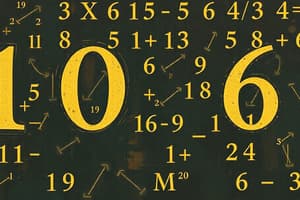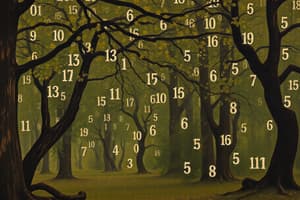Podcast
Questions and Answers
Which measure is NOT a standard unit for measuring liquid volume?
Which measure is NOT a standard unit for measuring liquid volume?
- Gallons
- Milliliters
- Liters
- Kilograms (correct)
What does the 'range' represent when analyzing data?
What does the 'range' represent when analyzing data?
- The sum of all data points
- The difference between the highest and the lowest data points (correct)
- The most frequently occurring data point
- The average of all data points
Which term describes the set operation that combines all elements from two sets into one single set?
Which term describes the set operation that combines all elements from two sets into one single set?
- Union (correct)
- Difference
- Intersection
- Complement
What represents the vertical axis on a standard graph when plotting a function?
What represents the vertical axis on a standard graph when plotting a function?
Which of these options best describes a situation when you would use a binomial distribution?
Which of these options best describes a situation when you would use a binomial distribution?
What is the result of combining two or more numbers?
What is the result of combining two or more numbers?
Which number system includes both positive and negative whole numbers, and zero?
Which number system includes both positive and negative whole numbers, and zero?
What is the property that states $a \times (b + c) = a \times b + a \times c$?
What is the property that states $a \times (b + c) = a \times b + a \times c$?
In the expression $5x + 2y - 7$, what is the constant?
In the expression $5x + 2y - 7$, what is the constant?
What do you call a mathematical statement that compares two expressions using symbols like $<$ or $>$?
What do you call a mathematical statement that compares two expressions using symbols like $<$ or $>$?
What is the term for the distance around a two-dimensional shape?
What is the term for the distance around a two-dimensional shape?
Which of the following is an example of an irrational number?
Which of the following is an example of an irrational number?
What is the result of repeatedly adding the same number?
What is the result of repeatedly adding the same number?
Flashcards
Domain of a function
Domain of a function
The set of all possible input values for a function.
Range of a function
Range of a function
The set of all possible output values for a function.
Linear function
Linear function
A function where the graph is a straight line.
Quadratic function
Quadratic function
Signup and view all the flashcards
Union of Sets
Union of Sets
Signup and view all the flashcards
Addition
Addition
Signup and view all the flashcards
Subtraction
Subtraction
Signup and view all the flashcards
Multiplication
Multiplication
Signup and view all the flashcards
Division
Division
Signup and view all the flashcards
Rational Number
Rational Number
Signup and view all the flashcards
Irrational Number
Irrational Number
Signup and view all the flashcards
Equation
Equation
Signup and view all the flashcards
Inequality
Inequality
Signup and view all the flashcards
Study Notes
Arithmetic Operations
- Addition combines two or more numbers to find their sum.
- Subtraction finds the difference between two numbers.
- Multiplication is repeated addition or a shortcut for adding identical numbers.
- Division splits a number into equal parts; it's the inverse of multiplication.
Number Systems
- Natural numbers (counting numbers): 1, 2, 3,...
- Whole numbers: 0, 1, 2, 3,... (includes zero)
- Integers: ..., -3, -2, -1, 0, 1, 2, 3,... (positive and negative whole numbers, and zero).
- Rational numbers: fractions (p/q where p and q are integers, q ≠ 0), terminating decimals, and repeating decimals.
- Irrational numbers: decimals that are non-repeating and non-terminating, like √2 and π.
- Real numbers: the set of all rational and irrational numbers.
- Complex numbers: numbers of the form a + bi, where 'a' and 'b' are real numbers, and 'i' is the imaginary unit (i² = -1).
Properties of Numbers
- Commutative property: a + b = b + a, a × b = b × a
- Associative property: (a + b) + c = a + (b + c), (a × b) × c = a × (b × c)
- Distributive property: a × (b + c) = a × b + a × c
- Identity property: a + 0 = a, a × 1 = a
- Inverse property: a + (-a) = 0, a × (1/a) = 1 (for a ≠ 0)
Algebraic Expressions
- Variables: symbols (like x, y, or z) that represent unknown values.
- Constants: numbers without variables.
- Terms: parts of an expression separated by addition or subtraction signs.
- Expressions: combinations of variables, constants, and operations. Example: 2x + 3y - 5
Equations and Inequalities
- Equations: statements that two expressions are equal. Solving involves finding variable values that make the equation true.
- Inequalities: statements comparing expressions using symbols like <, >, ≤, ≥, ≠. Solving involves finding the range of values that make the inequality true.
Geometry
- Basic shapes: points, lines, planes, angles, triangles, quadrilaterals, circles, polygons.
- Geometric figures: two-dimensional (2D) and three-dimensional (3D) shapes.
- Perimeter: the distance around a two-dimensional shape.
- Area: the space enclosed by a two-dimensional shape.
- Volume: the space occupied by a three-dimensional shape.
- Formulas for calculating areas and perimeters of different shapes.
Measurement
- Units of measurement: standard units (e.g., meters, centimeters, kilograms, grams, liters).
- Converting between units.
- Using formulas for area and volume.
- Significant figures.
- Accuracy and precision in measurements.
Data Analysis
- Collecting data.
- Organizing data (tables, charts).
- Analyzing data (mean, median, mode, range).
- Interpreting data (charts, graphs).
Probability
- Basic concepts of probability.
- Calculating probabilities of simple events.
- Probability distributions (normal, binomial).
Statistics
- Descriptive statistics (mean, median, mode, standard deviation).
- Inferential statistics (hypothesis testing).
- Data collection methods.
Functions
- Defining a function;
- dependent variable(s), independent variable(s).
- domain, range.
- Linear functions.
- Quadratic functions.
- Exponents/logarithms.
Sets
- Sets and their elements.
- Set operations (union, intersection, difference).
Studying That Suits You
Use AI to generate personalized quizzes and flashcards to suit your learning preferences.




